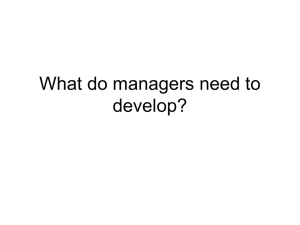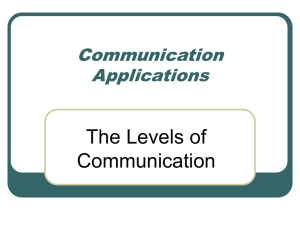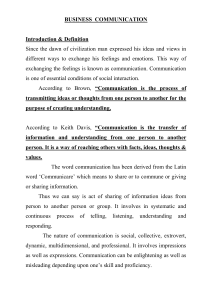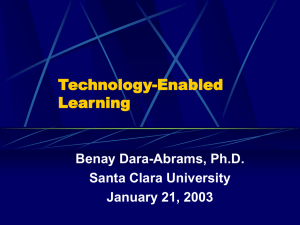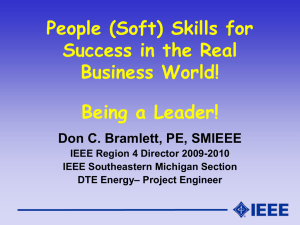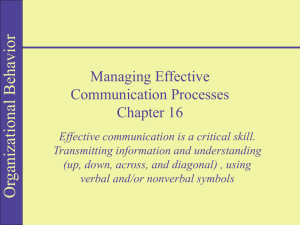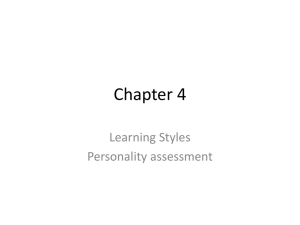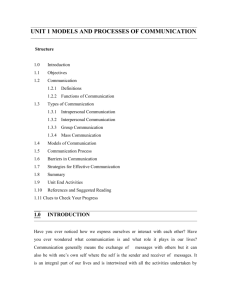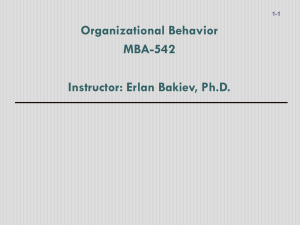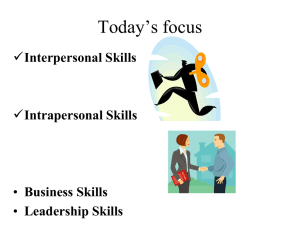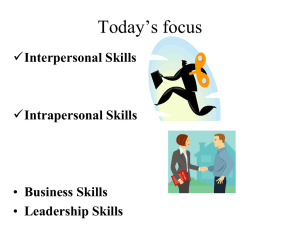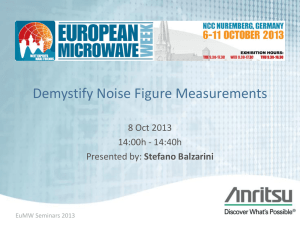chapter2_pce - Technoblogger.net
advertisement
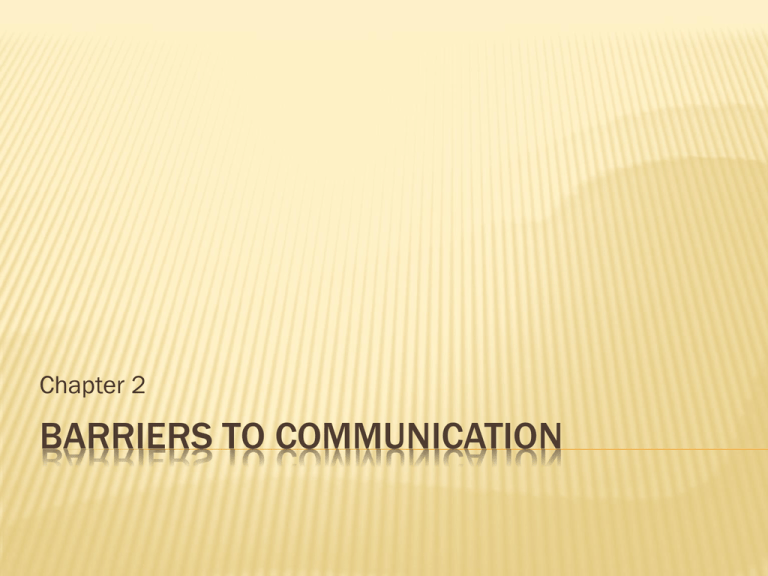
Chapter 2 BARRIERS TO COMMUNICATION SOME POINTS.. Communication is effective only if it creates the desired impact on the receiver. Problems while Communicating Disturbance/ Noise Either not put properly Message is not proper Or not meant for that audience STEPS TO RESOLVE COMMUNICATION FAILURE 1. 2. 3. 4. 5. Identify the problem Find the cause Work on alternative solutions Opt for the best solution Follow up religiously Example:- “Bimonthly” example WHAT IS NOISE Any interference in the message sent and received leads to the production of “noise”. Noise here does not mean cacophony(harsh sounds) but it refers to a break in the communication process. It is like a barrier in the communication. This barrier acts like a sieve that filters only part of the message thus causing undesired response. CLASSIFICATION OF BARRIERS 1. INTRAPERSONAL Stems from a person’s attitude, behaviour, knowledge, education and personality 2.INTERPERSONAL Stems from inappropriate transaction of words between two or more people. 3. ORGANIZATIONAL Refers to barriers in organizational communication INTRAPERSONAL BARRIERS All individuals are unique as we have different personalities, attitudes, values, knowledge etc We react differently to different situations as our thinking varies. Let’s explore the causes that lead to intrapersonal barriers: CAUSES OF INTRAPERSONAL BARRIERS Let’s explore the causes that lead to intrapersonal barriers:1. Wrong assumptions 2. Varied perceptions 3. Differing background 4. Wrong inferences 5. Impervious categories 6. Categorical thinking WRONG ASSUMPTIONS Wrong assumptions occur when sender and receiver does not have adequate knowledge about each other’s background. Sometimes speaker does not realize the background, education etc of the receiver. To be a good communicator try to put yourself in the shoes of the receiver.. Example – Doctor and Patient VARIED PERCEPTIONS Individuals perceive situations in different ways Best way is to step back and take a wider perspective of the whole situation. Example: Elephant and six blind men DIFFERING BACKGROUNDS Our background plays a very important role in how we interpret the message. To be a good communicator , the speaker should know about the background of the audience. Example:- A computer company representative explaining about hardware details about the hospital management system he plans to install to groups of doctors WRONG INFERENCES Wrong Inference is when we assume something without knowing the whole truth. They are more dramatic than facts and can cause gossip and rumors. Inference should always be supported by facts. When presenting inferences you should always some evidences or facts behind it. INTRAPERSONAL BARRIERS Wrong assumptions Varied Perceptions Differing Background Wrong Inferences Impervious Categories Categorical Thinking INTRAPERSONAL BARRIERS Impervious categories People with a closed mind attitude are called misoneists. They are against any kind of change or innovation. They do not agree to any kind of deviation from their thinking and ideas. These people might feel difficulty in communicating freely. People with a open mind would react positively to information. Example:- People being against computerization in their job. CATEGORICAL THINKING People who feel they know it all called pansophists. These people think they know everything about a subject and refuse to accept any further information. Example:- You do not to listen in your orientation programme as you think you know it all!!! TO SUM UP… Good Communication should be: Non judgmental Be empathetic Don’t assume anything Stick to the subject Listen and above all paraphrase ( to explain something in other words) INTERPERSONAL BARRIERS These barriers occur due to inappropriate transaction of words between two or more people. Two broad categories Inefficiency in communication skills Negative aspect nurturing in the climate COMMON REASONS FOR INTERPERSONAL BARRIERS 1. 2. 3. 4. 5. 6. Limited Vocabulary Incongruity ( mismatch) of Verbal or Nonverbal message Emotional outburst Communication selectivity Cultural variations Poor listening skills LIMITED VOCABULARY If in your speech or writing, you are at a loss of words, your communication will be very ineffective. On the other hand, if you have a good vocabulary and know how to use it properly, you would be a good communicator Interpersonal_Barriers_1 INCONGRUITY OF VERBAL AND NON-VERBAL MESSAGES The difference between verbal and non-verbal message can confuse the listener. Non-verbal communication enhances verbal communication. Actions speaks louder than words One very important aspect o non-verbal communication is physical appearance Interpersonal_Barriers_2 GUIDELINES TO IMPROVE APPEARANCE Dress according to the occasion Wear neat and clean clothes Choose an appropriate hairstyle Wear clean and polished shoes Interpersonal_Barriers_3 EMOTIONAL OUTBURST Excessive emotional involvement is harmful to communication. Example:- extreme anger can create an emotionally charged environment an rational discussion is not possible. Messages can be misinterpreted, ignored or overreacted to by people displaying such behaviour. Interpersonal_Barriers_4 GUIDELINES FOR AVOIDING EMOTIONAL OUTBURST It is important to maintain ones’ composure in all kinds of communication Viewing issues from different perspectives helps to develop rational thinking If confronted such negative thinking, it is important that you do not retaliate( react). Usually in emotional outburst situation, volume increases so it is good to keep the volume in check. COMMUNICATION SELECTIVITY If you are a receiver in any communication and you listen /pay attention to only a part of the messages, you are imposing a barrier known as Communication Selectivity. Here receiver is at fault and not the sender. This can also be part of written communication. Interpersonal_Barriers_5 CULTURAL VARIATION Business practices, social customs and etiquettes of a particular country should be taken into consideration when communicating with people across the globe. This has become very important as nowadays businesses are happening across national boundaries. POOR LISTENING SKILLS We should just not HEAR but LISTEN when we are the receiver in a communication process. Listening requires careful attention and accurate decoding of the message. Interpersonal_Barriers_6 NOISE IN THE CHANNEL Noise is any unwanted signal which acts as a hindrance in the flow of communication. Example- Disturbance in telephone lines, dim typescripts, illegible handwriting, noisy place etc… Interpersonal_Barriers_7 ORGANIZATIONAL BARRIERS Every organization has it’s communication techniques and communication climate. Irrespective of it’s size, all organizations have communication policies. These policies are referred as PROTOCOL. The complexity and structure of this protocol can cause communication barriers. MAIN ORGANIZATIONAL BARRIERS 1. Too many Transfer points 2. Fear of Superiors 3. Negative Tendencies 4. Information Overload TRANSFER STATIONS/ POINTS Transfer stations are points at which communication is passed. More the transfer stations, more is the likelihood of message being distorted or lost For effective communication, we should have less transfer points. In organizations, having rigid hierarchy, transfer points are more. To have less transfer points, there should be direct contact between sender and receiver. OrganizationalBarriers_1 WHY DO MESSAGES GET DISTORTED AT TRANSFER POINTS? 1. Poor Listening Lack of concentration Person’s tendency to leave out part of the message OrganizationalBarriers_1 FEAR OF SUPERIORS In rigidly structured organization, subordinates would be fearful of the superiors and would not talk frankly. On the other hand, in an open environment people will speak freely and will have active participation during meetings with their seniors. OrganizationalBarriers_2 FEAR OF SUPERIORS In written Communication Rigid Environment – Employees might give all information that they have in fear and end up giving too bulky reports. Such unfocussed reports can be a wastage of time. Open Environment – Communication will flow effectively in the organization. OrganizationalBarriers_2 NEGATIVE TENDENCIES Negative tendencies can arise due to improper management of groups in an organization. Groups can be formal or informal. There can be conflict of ideas between group members and non-group members. Example:- Extra-curricular activities group in class being opposed by others. But good managers can use these groups for the effective working of the organization. OrganizationalBarriers_3 USE OF INAPPROPRIATE MEDIA What are the different types of media that can be used in an organization for communication? Graphs and Charts, email, telephone, presentations, teleconferencing, video-conferencing etc Some factors to consider while choosing a medium: time, cost, type of message, intended audience OrganizationalBarriers_4 WHEN TO USE WHAT? What would you choose?? 1. Conveying confidential information 2. Declaring company outing 3. Giving offer letter to a candidate 4. Applying for leave OrganizationalBarriers_4 INFORMATION OVERLOAD Availability of huge amounts of data which the receiver is unable to handle. Results in Fatigue Disinterest/Boredom Vital information can get lost Quality of information goes down OrganizationalBarriers_5 INFORMATION OVERLOAD What can be done to avoid information overload? Screening of information Major points to be highlighted Information should be directed only to those who are affected by it. Example:- Calendar of events for students should not include teacher’s department meeting schedule!! OrganizationalBarriers_4 EFFECTIVE COMMUNICATION 1. 2. 3. 4. 5. 6. 7. 8. Open environment Keep receiver in mind Avoid too many transfer points Do not communicate when emotionally disturbed Be aware of cultural diversity Use appropriate non-verbal cues Select suitable medium Analyze feedback
